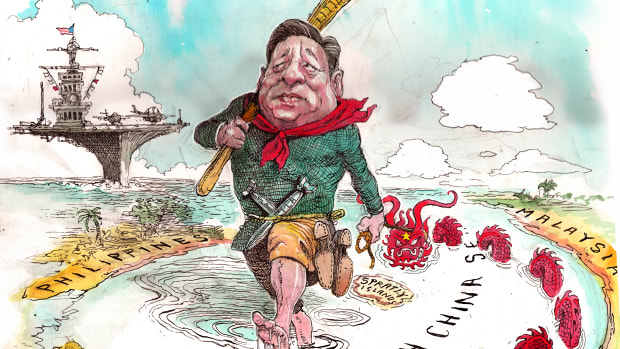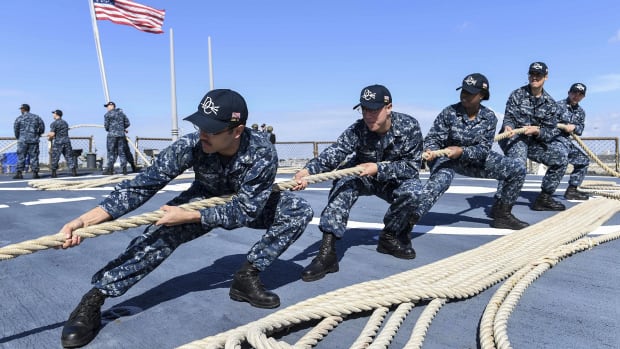Ironically, the threat comes as the most conspicuous flash point between the two countries, China’s military buildup on its artificial islands in the South China Sea, appears to be reaching a peak. In part, this is because of limits on the bases’ military usefulness in future conflict.
The key reason, however, is that the backlash and counterbalancing that China's militarisation encourages from the United States and others threaten the islands’ usefulness as a political signal at home, something that the Communist Party may value far more than their actual military potency.
The purpose of China's manmade South China Sea islands may be more to shore up power at home than abroad. David Rowe
Since 2013, China has constructed more than 3000 dredged-up acres across seven features that are now studded with long-range sensor arrays, port facilities, runways, and reinforced bunkers for fuel and weapons.
That’s a huge military footprint, despite Chinese President Xi Jinping’s nominal 2015 pledge not to militarise the islands and the Foreign Ministry’s claims that these “necessary defence facilities” are provided primarily for maritime safety and natural disaster support.
But as conspicuous as the bases’ capacity to project China’s offensive power is how little of that might Beijing has actually deployed there. The Pentagon’s latest report on China’s military notes that no new militarisation has been observed since China placed air defence and anti-ship missiles in the Spratlys last year.
General Joseph Dunford, the chairman of the US Joint Chiefs of Staff, recently remarked that if China’s militarisation of the islands had plateaued, it was because they had achieved the military capability China required of them. If that’s true, then China requires much less of those bases militarily than their apparent potential to deliver.
Despite the islands’ scale, China’s maximalist regional claims, and its aggressive coercion of regional rivals, tension between China’s political and military incentives suggest it has little more to gain from expanding its buildup in the Spratly Islands and it could even have quite a bit to lose.
Additional overt militarisation doesn’t help China exert control over the South China Sea in peacetime and may not be decisive in wartime. It also encourages a greater and more public US military presence, undermining the islands’ political symbolism. It also reduces China’s room for diplomacy and de-escalation in a crisis, increasing the potential for an uncertain and potentially embarrassing clash that would risk further undermining the party’s legitimacy.
The United States can leverage those incentives to its advantage as it debates how to implement the Pentagon’s National Defence Strategy, but if it pushes back too hard, the Communist Party may feel it has to escalate to preserve its legitimacy.
A man-made Chinese airstrip in the heavily contested South China Sea. AP
China is hardly reticent in asserting its maximalist claims over the South China Sea. Its law enforcement and paramilitary maritime militia vessels, often operating out of those same bases in the Spratly Islands, keep up a strong campaign of harassment and coercion against coastal states with competing claims and in contravention of provisions in the United Nations Convention on the Law of the Sea and a 2016 international arbitration rulingthat nullified most of China’s claims.
But compared with the expanding shadow of China’s gray-zone activity, the military presence on its Spratly bases is anaemic. In early 2016, US intelligence assessed that those bases would be capable of hosting significant force projection capabilities by the end of that year. Three years on from that assessment, China has yet to deploy warplanes or other long-range strike weapons that can hit land targets to the islands, though they appear more than capable of accommodating them.
Instead of the vital maritime crossroads that China depends on for its energy imports, it might instead find itself in control of a virtual lake.
One explanation is that the region’s climate simply isn’t hospitable to China’s most advanced military systems. Chinese state media reported in 2017 on special measures required to protect a short deployment of J-11 fighter jets to the Paracel Islands (which were not covered by Xi’s 2015 pledge) from the island’s heat and humidity.
More recent reports claim that China’s environmental problems in the Spratlys are even more serious, with heat and humidity causing structures to crumble, mechanical equipment to fail, and even some weapon systems to break down. This is on top of persistent concerns about the artificial islands’ ability to withstand a major Pacific weather event – and a poor record of equipment and infrastructure maintenance in general in an often corruption-riddled People’s Liberation Army (PLA).
Peacetime assets but wartime liabilities
The islands are useful during peacetime to monitor rivals’ air and sea movements and as a base for coast guard and maritime militia operations against those countries’ fishermen and hydrocarbon exploitation. But increasing its overt military capability on the islands neither increases China’s practical civil control over waters crowded with rival fishermen and law enforcement vessels nor deters the presence of US and other foreign warships and planes. And in wartime, that additional militarisation may not translate to a decisive advantage over the United States anyway.
The bases’ distance and isolation from China’s mainland leave them comparatively exposed, and their military utility will diminish rapidly the longer a conflict goes on. In the early stages of a clash, the bases provide the PLA with positions to stage preemptive missile and airstrikes and resupply its ships and aircraft. But the Spratlys are also more than 500 nautical miles from their closest point of resupply, China’s naval and air bases on Hainan Island. They are much closer to the Philippines, an occasionally strained USally but one increasingly sceptical of China’s intentions.
The islands are also fixed, relatively small, and isolated targets with no so-called civilian collateral on them and provide little cover or protection, especially against new long-range precision strike weapons and island raid and seizure operations that the US military is developing.
In a conflict with the United States, as those bases became damaged and degraded through air and missile strikes, repairing and resupplying them would become increasingly expensive and challenging, drawing away warships and air cover that the PLA might prefer to commit elsewhere rather than using them to protect islands with rapidly shrinking usefulness.
The strategic value of China’s Spratly bases in a conflict is similarly dubious. The bases are more than 800 nautical miles from the crucial Singapore Strait and as much as twice that by sea to the nearest alternate passages, Indonesia’s Sunda and Lombok straits. Their central location might help China control the South China Sea’s interior but not the maritime choke points in and out of it.
In a conflict, China’s South China Sea neighbours, with help from the United States and other coalition partners, could close those choke points to China’s naval and merchant fleets. Instead of the vital maritime crossroads that China depends on for 80 per cent of its energy imports, China might instead find itself in control of a virtual lake, and that only briefly, given the islands’ other liabilities.
Building islands, constructing legitimacy
These limitations on the bases’ strategic and operational value demand an alternative theory for their construction: the governing legitimacy and political primacy of China’s Communist Party.
Chatham House fellow Bill Hayton’s historical research shows that China’s territorial claims to the South China Sea emerged across several governments over the past century during periods of flagging domestic support to bolster governments’ popular legitimacy. That historical context aligns with the conclusions of regional observers like Bilahari Kausikan, a long-serving senior Singaporean diplomat.
He argues that the Communist Party depends on the image of defending the state’s territorial integrity and sovereignty to maintain support and that the party can perform its role as the defender of Chinese sovereignty on the unpopulated reefs of the South China Sea, compared with a place like Taiwan, at minimal cost or risk of humiliation or defeat.
This interpretation is bolstered by the recent research of Paul Musgrave and Daniel Nexon. They show that extravagant national projects with costs that outweigh obvious strategic returns, like the bloated Belt and Road Initiative, are commonly efforts to buy back domestic legitimacy or secure a state’s place within the international hierarchy.
Through this lens, the thousands of acres of reclaimed land and the massive runways, hangars, bunkers, and headquarters built in the Spratly Islands are better understood for the symbolic political capital they provide the Chinese regime than their straightforward military value.
The presence of the US military in the South China Sea has helped to keep Beijing's ambitions in check. US Navy
Bolstering the Communist Party’s primacy and China’s position at the top of south-east Asia’s regional hierarchy may not be the exclusive benefit of its South China Sea bases, but it appears to be the most important one. Even recent party publications espouse the island buildup as a demonstration of the Communist Party’s “steadfast determination” to defend China’s sovereignty. This nationalistic underpinning of its governing legitimacy will only become more important as the party ratchets up domestic social repression and the economy slows.
Using China’s anxiety to limit militarisation
If the United States pulled back its regional presence to appease Chinese anxieties over the expanding US presence in the region, China is likelier to use the opportunity to reinforce its position than content itself with the gains it has made to date.
Despite China’s often strident rhetoric, the presence of the US military in the South China Sea has generally heightened its sensitivity to provoking even stronger military responses and motivated greater, if dubiously productive, diplomatic engagement with its neighbours.
To provide the Communist Party that symbolic political capital, China’s Spratly bases simply need to exist, incentivising China to limit the threat those islands pose. The appearance of new high-profile weapons systems on the islands, only to have the US Navy and Air Force defy the Chinese presence with sail-bys and flyovers, makes China’s buildup appear impotent, damaging its symbolic value for the Communist Party.
The Communist Party’s political imperatives compel it to defend its Spratly bases against both genuine threats and capricious humiliation, so the United States should avoid gratuitous shows of force that would demand an escalatory Chinese response.
RELATED
How Bob Carr became China's pawn
But those imperatives also incentivise China not to escalate (in real terms if not rhetorical ones) against a routine US military presence and lesser trespasses to avoid the risk of needless humiliation. That gives the United States and its partners wide latitude for assertive policies credible enough to hedge against the most dangerous conflict scenarios while also discouraging additional Chinese militarisation of the Spratly Islands.
Steven Stashwick is an independent writer and researcher based in New York City focused on East Asian security and maritime issues.






No comments:
Post a Comment